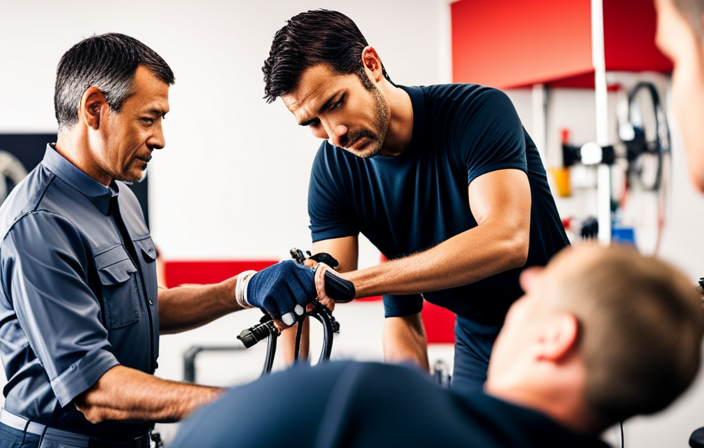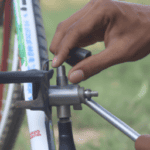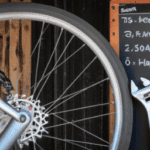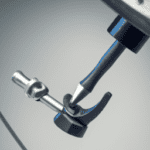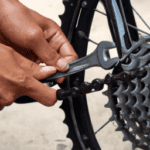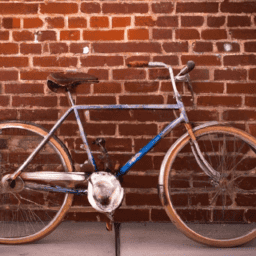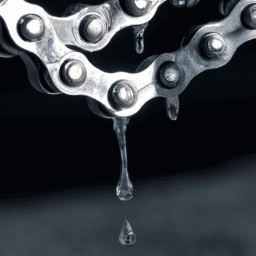As someone passionate about cycling, I understand the critical role that properly working bicycle brakes play. They are like the heartbeat of a bike, ensuring our safety and control.
But what happens when those brakes start to falter? How much will it cost to get them fixed? In this article, we’ll explore the different types of bicycle brakes, common issues that arise, factors that affect repair costs, and whether it’s better to go the DIY route or seek professional help.
Let’s dive in and find out the true cost of keeping our brakes in top shape.
Key Takeaways
- Inquire about labor fees and warranty options when getting bicycle brakes fixed.
- Look for a reliable bike shop with skilled technicians specializing in bicycle repairs.
- Regular brake inspections and maintenance are crucial for safety and optimal performance.
- Understand DIY brake repair tips, such as brake pad replacement and brake cable tension adjustment.
Different Types of Bicycle Brakes
If you’re looking to understand the different types of bicycle brakes, you’ll find that there are several options available to choose from. The most common types of bicycle brakes include rim brakes, disc brakes, and drum brakes.
Rim brakes, such as caliper brakes and V-brakes, are mounted on the rim of the wheel and provide good stopping power. However, they can wear down the rim over time.
Disc brakes, on the other hand, use a rotor and caliper system for stopping power and are less affected by wet conditions. They do require specific mounting points on the frame or fork.
Drum brakes are less common and are typically found on cruiser bikes. They offer good braking power but can be heavier and less efficient.
Understanding the pros and cons of each type will help you choose the right brakes for your bike.
Now, let’s transition into the subsequent section about common brake issues.
Common Brake Issues
To address common brake issues, you should consider having them repaired. Ignoring brake problems can lead to serious safety risks while riding your bike. Here are some signs of brake issues that you should be aware of:
- Squeaking or grinding noises when applying the brakes
- Reduced braking power or a longer stopping distance
- Brake lever feels spongy or loose
- Brake pads worn down to the metal
- Uneven braking force between the front and rear brakes
If you experience any of these problems, it’s important to get your bicycle brakes fixed as soon as possible. Ignoring them can result in further damage and potentially costly repairs down the line.
Now, let’s dive into the factors affecting the cost of brake repairs.
Factors Affecting the Cost of Brake Repairs
When it comes to brake repairs, there are several factors that can affect how much you’ll need to spend. One of the main factors is the condition of your brake components. If your brake pads are worn out or your brake rotors are damaged, you may need to replace them, which can increase the cost of the repair.
Another factor that affects brake performance is the type of brake pads you choose. There are different types of brake pads available, including organic, semi-metallic, and ceramic. Each type has its own advantages and disadvantages, and the cost can vary depending on the material.
Additionally, the labor cost can vary depending on the complexity of the repair and the shop you choose. Considering these factors, it’s important to choose the right brake pads and consider the overall cost when getting your bicycle brakes fixed.
This leads us to the next section about DIY vs. professional repairs.
DIY vs. Professional Repairs
When it comes to brake repairs, there are three key points to consider: basic brake maintenance, intermediate brake repairs, and complex brake issues.
For basic brake maintenance, tasks like cleaning and lubricating the brake components can be easily done by oneself with some basic tools and knowledge.
However, when it comes to more intermediate repairs such as replacing brake pads or adjusting brake cables, it may be best to seek the help of a professional to ensure the job is done correctly.
Lastly, complex brake issues like replacing brake calipers or bleeding the brake system should always be done by a professional as these tasks require specialized tools and expertise.
Basic Brake Maintenance
The cost of getting bicycle brakes fixed depends on the extent of the maintenance needed. Basic brake maintenance usually involves tasks such as brake pad replacement and brake cable adjustment. These are relatively simple tasks that can be done by most bike owners with some basic tools and knowledge. However, if you are not confident in your abilities or if the brakes require more extensive repairs, it is recommended to seek the help of a professional.
To give you an idea of the cost, here is a breakdown of the average prices for basic brake maintenance:
| Task | Cost |
|---|---|
| Brake pad replacement | $10 – $30 |
| Brake cable adjustment | $15 – $35 |
Keep in mind that these prices can vary depending on your location and the specific bike shop you visit.
Moving on to intermediate brake repairs, there are additional tasks that may be required to ensure your brakes are working properly.
Intermediate Brake Repairs
Now that we have covered the basics of brake maintenance, let’s move on to intermediate brake repairs. These repairs go beyond simple maintenance and require a bit more expertise.
When it comes to intermediate brake repairs, one important aspect is brake adjustment techniques. Properly adjusted brakes ensure optimal performance and safety while riding. Here are some key techniques to consider:
- Adjusting brake pad alignment: Making sure the brake pads are properly aligned with the rim or rotor.
- Adjusting cable tension: Ensuring the brake cables have the right amount of tension for effective braking.
- Centering brake calipers: Checking that the brake calipers are centered and evenly contacting the rim or rotor.
By mastering these intermediate brake repair techniques, you can significantly improve the performance of your brakes. However, if you encounter more complex brake issues, it may be time to seek professional assistance.
Complex Brake Issues
If you’re facing more intricate brake problems, it might be best to consult a professional for assistance. Complex brake issues can be challenging to diagnose and resolve without the proper knowledge and tools.
However, there are a few troubleshooting techniques you can try before seeking professional help. Firstly, check for any loose or worn brake pads and replace them if necessary. Next, inspect the brake cables for any signs of fraying or damage and replace them if needed. Additionally, ensure that the brake calipers are properly aligned and adjusted.
If these steps don’t resolve the problem, it’s time to bring your bike to a professional mechanic. They have the expertise to tackle complex brake issues and ensure your bike is safe to ride.
Now, let’s move on to discussing the average cost of brake repairs.
Average Cost of Brake Repairs
On average, it’ll cost you about $50 to $100 to get your bicycle brakes fixed. The price can vary depending on various factors such as the type of brakes you have, the severity of the issue, and where you get the repairs done.
Here are some brake repair options to consider:
-
DIY: If you’re handy with tools, you can try fixing the brakes yourself, which can save you money.
-
Local bike shop: Taking your bike to a local bike shop is a convenient option, and they can provide professional repairs.
-
Mobile bike repair service: Some places offer mobile repair services, where they come to you and fix your brakes on the spot.
-
Online tutorials: There are plenty of online tutorials and videos available that can guide you through brake repairs.
-
Warranty service: If your bike is still under warranty, you may be able to get the brakes fixed for free.
When considering the average cost of brake repairs, it’s also important to keep in mind any additional costs to consider, such as replacement parts or labor fees.
Additional Costs to Consider
Take into account any other expenses that may arise when getting your bicycle brakes fixed.
In addition to the average cost of brake repairs, there are additional costs that you should consider. One of the main additional costs is the price of replacement parts. Depending on the type and quality of the parts needed, the cost can vary. It is important to discuss this with the bike shop beforehand to get an estimate of the total cost.
Another potential additional cost is the fees for labor. Some bike shops charge a flat rate for labor, while others charge by the hour. Make sure to inquire about labor fees to avoid any surprises.
Now that you are aware of the additional costs associated with brake repair, let’s move on to finding a reliable bike shop where you can get your brakes fixed.
Finding a Reliable Bike Shop
When considering the additional costs of getting your bicycle brakes fixed, it’s important to find a reliable bike shop that offers quality service at a fair price. Finding the best bike shop can be a daunting task, but asking the right questions can help you make an informed decision.
First and foremost, inquire about their experience and expertise in handling brake repairs. A reputable shop will have skilled technicians who specialize in bicycle repairs. Additionally, ask about the turnaround time for brake repairs and if they offer any warranties on their work. It’s also worth checking if they have a good selection of brake parts in case any replacements are necessary.
By finding a reliable bike shop, you can ensure that your brakes are fixed properly and at a reasonable cost.
Now, let’s move on to some preventive maintenance tips to keep your bicycle in excellent condition.
Preventive Maintenance Tips
When it comes to preventive maintenance for your bicycle, there are three key areas to focus on:
-
Regular brake inspections: These are crucial to ensure the safety and effectiveness of your braking system.
-
Cleaning and lubrication: This will help to keep your brakes functioning smoothly and prevent build-up of dirt and debris.
-
Brake adjustment techniques: Knowing how to properly adjust your brakes will ensure optimal performance and prevent unnecessary wear and tear.
By taking these preventive measures, you can keep your brakes in top-notch condition and enjoy a safe and smooth ride.
Regular Brake Inspections
Regular brake inspections are essential for maintaining the safety and performance of your bicycle. To ensure your brakes are in top condition, it’s important to regularly inspect them for any signs of wear. Here are three key things to look out for during your inspection:
-
Brake Pad Wear: Check the brake pads for any signs of thinning or uneven wear. If they are worn down to less than 3mm, it’s time to replace them.
-
Brake Cable Tension: Ensure that the brake cables are properly tensioned. They shouldn’t be too loose or too tight, as this can affect braking efficiency.
-
Brake Lever Action: Test the brake lever action to ensure it feels firm and responsive. If it feels spongy or requires excessive force, it may indicate a need for adjustment or repair.
Regular brake inspections will help you catch any issues early on and prevent further damage or accidents.
Now, let’s move on to the next section about cleaning and lubrication.
Cleaning and Lubrication
To maintain your bicycle’s performance, it’s important to regularly clean and lubricate it.
Cleaning your bicycle’s brakes is essential to remove dirt, debris, and grime that can affect their performance. Start by using a clean cloth or a soft brush to gently wipe away any dirt from the brake calipers and brake pads. You can also use a mild detergent or a specific brake cleaner for stubborn dirt.
Once the brakes are clean, it’s time to lubricate them. Apply a small amount of recommended lubricant to the pivot points of the brake calipers, ensuring smooth movement. Avoid applying lubricant directly to the brake pads or the braking surface to prevent reduced braking power.
With clean and properly lubricated brakes, you can ensure optimal performance and reliable stopping power.
Now, let’s move on to brake adjustment techniques.
Brake Adjustment Techniques
Now that we’ve covered the importance of cleaning and lubricating your bicycle brakes, let’s move on to the next step: brake adjustment techniques.
When it comes to maintaining optimum brake performance, two key aspects to consider are brake pad replacement and brake cable adjustment.
Brake pad replacement is necessary when you notice a decrease in braking power or excessive wear on the pads. This can be done by removing the old pads and installing new ones, ensuring they are properly aligned with the rim.
Additionally, brake cable adjustment is crucial for achieving the right amount of tension and responsiveness in your brakes. By adjusting the cable tension, you can fine-tune the brake’s engagement and release.
By mastering these brake adjustment techniques, you can ensure your brakes are in top shape and ready to stop you safely.
In the next section, we will delve into some valuable DIY brake repair tips that will further enhance your brake maintenance skills.
DIY Brake Repair Tips
When it comes to DIY brake repair, there are three key points to consider.
First, understanding the steps for brake pad replacement is crucial to maintaining an efficient braking system.
Second, adjusting the brake cable tension properly ensures the brakes engage and disengage smoothly.
Lastly, bleeding hydraulic brake systems is necessary to remove any air bubbles and maintain optimal brake performance.
By following these steps, you can confidently address brake issues and keep your bike in top condition.
Brake Pad Replacement Steps
Replacing brake pads on a bicycle is a straightforward process. First, gather the necessary brake pad replacement tools, including a 5mm Allen wrench and a new set of brake pads.
Next, inspect the brake pads for wear by looking for any signs of unevenness or thinning. If the pads are worn, it’s time to replace them.
To remove the old pads, use the Allen wrench to loosen the brake pad retention bolt and slide the pads out.
Then, insert the new pads into the brake caliper, making sure they are aligned correctly.
Finally, tighten the brake pad retention bolt and test the brakes to ensure they are functioning properly.
Now, let’s move on to adjusting brake cable tension for optimal brake performance.
Adjusting Brake Cable Tension
To adjust brake cable tension, follow these steps:
-
First, locate the barrel adjuster on your brake lever. Turn it clockwise to increase tension or counterclockwise to decrease tension.
-
Next, check the brake pads for proper alignment. They should be centered on the rim and make contact evenly when the brake lever is squeezed. If the pads are misaligned, loosen the brake pad mounting bolt and adjust the pads until they are properly aligned. Once the pads are aligned, tighten the mounting bolt securely.
-
Finally, test the brakes by squeezing the lever. If the brake lever feels too loose or too tight, adjust the tension again until you achieve the desired feel. This will ensure proper brake cable maintenance and effective braking.
Moving on to bleeding hydraulic brake systems, it is important to follow the correct procedure to maintain brake performance.
Bleeding Hydraulic Brake Systems
When it comes to bicycle brake maintenance, adjusting brake cable tension is just one aspect. Another important maintenance task is bleeding hydraulic brake systems. Bleeding hydraulic brakes involves removing any air bubbles that may have entered the brake lines, ensuring optimal performance and safety. This process requires a bleeding kit and specific tools to properly execute the bleeding technique.
One of the major benefits of hydraulic brakes is their superior stopping power and modulation. However, over time, air can infiltrate the system, causing a decrease in braking performance. Bleeding the brakes ensures that the hydraulic fluid is free from air bubbles, allowing for consistent and reliable braking power.
In conclusion, bleeding hydraulic brake systems is an essential maintenance task that guarantees optimal performance and safety. Now, let’s dive into the conclusion and final thoughts on the cost of getting bicycle brakes fixed.
Conclusion and Final Thoughts
In conclusion, you’ll be pleased to know that getting your bicycle brakes fixed won’t break the bank.
When it comes to preventing brake issues, there are a few key factors to consider. Firstly, choosing the right brake pads is essential. Look for pads that are compatible with your specific brake system and riding style. Organic pads offer good stopping power and are quieter, while metallic pads are more durable and better suited for extreme conditions.
Secondly, regular maintenance is crucial in preventing brake issues. Keep an eye on your brake pads for wear and replace them when necessary. Additionally, make sure your brake system is properly aligned and adjusted.
By following these steps, you can ensure the longevity and effectiveness of your bicycle brakes without spending a fortune.
Frequently Asked Questions
Are there any warranties or guarantees offered by bike shops for brake repairs?
Yes, many bike shops offer warranty options and guarantees for brake repairs. These warranties vary in terms of coverage and duration, so it’s important to inquire about them. Customer satisfaction levels are typically high when these warranties are available.
Can I use generic brake pads instead of the manufacturer’s recommended ones?
Using generic brake pads instead of the manufacturer’s recommended ones may seem like a cost-effective choice, but it can lead to poor performance and potentially costly repairs. It’s better to stick with the recommended pads for optimal safety and performance.
How often should I replace my brake cables?
When to replace brake cables depends on usage and conditions, but a general guideline is every 1-2 years. Signs of worn out brake cables include fraying, rust, decreased braking performance, and difficulty in shifting gears.
Are there any safety concerns if I attempt to repair my own brakes?
There are safety precautions to consider when attempting to repair your own bike brakes. It’s important to have proper tools, knowledge of the brake system, and an understanding of common brake problems to ensure a safe and effective repair.
Do bike shops offer any discounts or promotions for brake repairs?
Bike shops often offer discounts and promotions for brake repairs, which can help you save money. They may have special deals during certain times of the year or offer discounts for new customers.
Conclusion
In conclusion, getting your bicycle brakes fixed can be compared to tending to a wounded warrior. Just like a skilled doctor, a reliable bike shop will diagnose the issue and provide the necessary treatment.
While the cost may vary depending on factors like brake type and severity of the problem, it’s always best to entrust the job to a professional. However, if you’re a DIY enthusiast, don’t shy away from learning some basic brake repair skills.
Remember, regular preventive maintenance is key to keeping your brakes in top shape. Happy riding and safe braking!
